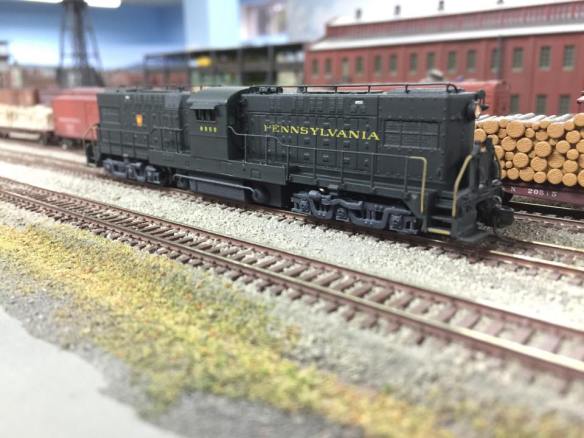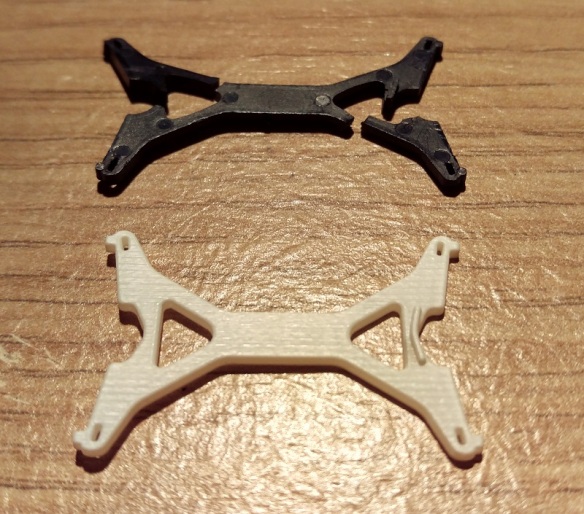As hinted at in last week’s post I’ve been working on the dummy chassis for the Alco C-855 and C-855B. This week I’m going to share some of the progress with you. You can read the first part here.
The actual chassis for the locomotive is a simple shape and as it fits inside the shell there’s no detail to add, with the exception of the air tank behind the fuel tank. However, as this is normally hard to see I’m happy to 3D print the whole chassis in Shapeways’ White Strong & Flexible material. This is a real bonus as, given the size of the chassis, it would be expensive in their Frosted Ultra Detail or Frosted Extreme Detail materials. The WS&F is still very accurate which means the truck bolster pin holes will be in the right place as will the shell locating positions.
The trucks are very visible and in order to show as much detail as possible these have been designed to be 3D printed in the FUD or FXD which is currently the best quality 3D print material they offer.
In the last post about these trucks I showed you the first few steps which led to the basic truck and bolster pin connection being designed, as you can see in the image below.

Since then I have developed the span bolster connection between the two trucks. Unlike the prototype, which had a solid bar connection from coupling to coupling, the model uses a bolster pin to connect the lead truck to the chassis and the second truck simply floats between the first truck and the fuel tank. The powered chassis trucks, shown below, are made of several parts which screw together forming a permanent connection, which can swivel side to side and has some up and down movement.

3D printing has the advantage of being able to produce the two trucks as one piece while keeping the movement between them. Below is a section taken through the trucks in which you can see their connection. The truck on the left has a lug on the back with a slotted hole in the end. The truck on the right has a slot in the cross member which the lug passes through. It also has a pin which passes through the hole in the lug preventing the trucks from separating. The two trucks are inseparable and to make this as one piece in any other way would be impossible.

Below is render of the front pair of trucks.
 The second truck has no bolster pin connection on top but I’ve left a level area to add a weight if required. The weight may be required if the truck lifts or bounces as the loco crosses turnouts.
The second truck has no bolster pin connection on top but I’ve left a level area to add a weight if required. The weight may be required if the truck lifts or bounces as the loco crosses turnouts.
At the rear of the second truck is a tail which fits into the gap in the chassis fuel tank. When the trucks are fitted to the chassis with the bolster pin the tail will stop the trucks from rotating out, but will still allow the trucks to swing enough on corners.
At the front of the trucks is the coupling connection. As with my other models I’ve added a pocket to accept a Micro-Trains body mount coupler. The pocket is upside-down so the coupler drops in from the top and is fixed with the standard small screw. This was done to maintain the strength of the pocket without adding extra material; if the coupling was fitted from below the coupling areas would be very bulky which is expensive and wouldn’t look right. On either side of the coupling pocket I’ve added the walkway texture which forms part of the access steps to the front of the locomotive. The rear set of trucks, as pictured below, doesn’t have this detail, nor does it have such a big pilot. The pilot is the area around the coupling.

The C-855B dummy chassis will have the rear set of trucks at each end as there aren’t any access steps at the ends of the B Unit.
With the designs complete the C-855 dummy chassis and trucks were sent to print and arrived looking very nice.

The chassis section, as it’s printed in WS&F, was ready to use right away, but the trucks needed their normal cleaning to remove the waxy residue left over from the print process.
The chassis was a prefect fit inside the shell. With the powered chassis I designed a replacement fuel tank which fitted to the underside of the metal chassis as shown below.

This fuel tank section had holes in the sides to locate the shell lugs. The dummy chassis has these same holes so the shell clips on and can only be removed by spreading the shell.
The holes for the bolster pins had a bit of surplus material in them so I reamed them out with a drill bit which was roughly the same size as the hole. Then I was able to fit the two sets of trucks, making sure the correct truck was at the front and the tails were in the fuel tank slots.
The Fox Valley wheel sets dropped in nicely to the trucks and then the dummy chassis was ready for some testing.

A UP heritage unit had the pleasure of pushing the dummy C-855 around our ‘Solent Summit’ layout this weekend at a running meet and it went very well.
I had put some weight inside the fuel tank area, as you can see below, and with the added weight of the metal wheels the dummy chassis tracked very well across turnouts and through bends. I will probably add a bit more so when the weight of a large train is behind the locomotive it won’t try and roll as the train runs around corners.

I am going to make a slight change to the spacing of the trucks by changing the length of the connecting lug so it perfectly matches the Con-Cor trucks used on the power chassis; currently they are spaced slightly closer together and I may add a little bit more depth to the truck frames just so they look exactly the same.
The next thing for me to check is the coupling fitting and height which I will be doing next week but for now I aam very happy with the C-855 Dummy Chassis.

The design for this chassis, once complete, can easily be tweaked to fit the Con Cor U50 and Gas Turbine chassis and I’ll be sharing that with you soon.

 With the fuel tank and trucks painted in acrylic ‘locomotive black’, the loco looks the part and spent some time last weekend running around our club layout behind other locomotives.
With the fuel tank and trucks painted in acrylic ‘locomotive black’, the loco looks the part and spent some time last weekend running around our club layout behind other locomotives.







 The second truck has no bolster pin connection on top but I’ve left a level area to add a weight if required. The weight may be required if the truck lifts or bounces as the loco crosses turnouts.
The second truck has no bolster pin connection on top but I’ve left a level area to add a weight if required. The weight may be required if the truck lifts or bounces as the loco crosses turnouts.































You must be logged in to post a comment.